"New York's Adirondacks are rugged and dramatic, but what distinguishes them from the mountain ranges in Vermont and New Hampshire is their waters, the hundreds of lakes and ponds and miles and miles of rivers that the others simply do not have". - THE NEW YORK TIMES
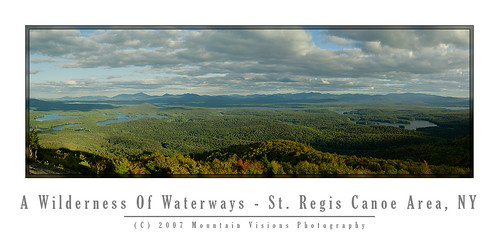
What the New York Times said has always been my thoughts when trying to explain the Adirondacks to people not familiar with the region. Sure there are mountains, beautiful rugged mountains at that, but it is the view from the summits of those mountains that is unlike most other places east or west of the Mississippi. I'm sure most people look out and see the other mountains, their next High Peak to bag on the way to a 46'er patch, but my primary interest when I look out is all that water!
Climbers look out at summits and cliffs looking for their next climbing objective, paddlers look out from summits in search of their next paddle. To me it's always been a wilderness of waterways first, with some mountains mixed in for fun during the winter months! The Adirondacks are one of the few publicly accessible places I can think of with such a mix of mountain and water, that is what makes them unique to me!
There are still dozens of bigger bodies of flat water with wilderness character, or perhaps even completely wilderness that we haven't yet paddled. My goal this year was to spend time on some of those, as well as some of the places we have only been to one or two times over the last 10 years. While we've paddled all the "old classics" time and again, it's nice to know there are many more future classics on the horizon!
The list this year includes the Grass River and Grass River Flow, Deer River and Deer River Flow, St Regis River and Santa Clara Flow, Madawaska Flow and Quebec Brook, Stillwater Reservoir, return trips to both ends of the Osgood River, perhaps a fall trip down the Fulton Chain after the summer tourist and motor boats have long gone. We might even look at pond hopping the Pigeon Lake Wilderness, but perhaps that is for next year. Of course, it's been almost 5 years since our last trip to the incredible Oswegatchie, this time though, instead of the usual 14 mile upstream paddle to High Falls, I think we'll do it as a paddle/backpack into some of the off river ponds!
With some regret, I'm putting the crown jewel of Adirondack river paddles, the Jordan River, off for one more year till we perhaps have a lighter 2 person boat or second single seater; both options would be better suited for pulling over obstacles on the beautiful -but blowdown choked- meandering wilderness river. It's been almost 3 years since we first paddled the Jordan but rest assured, we will paddle the entirety of the Jordan soon enough. The late Paul Jamieson made sure the once inaccessible river was indelibly ingrained in my imagination.
Wednesday, June 30, 2010
The Adirondack Mountains...A Wilderness Of Waterways
Posted by
Justin Serpico
at
Wednesday, June 30, 2010
0
comments
![]()
Technorati: Adirondacks, Beaver River, Madawaska, mountains, New York Times, paddling, Quebec Brook, Santa Clara Flow, St Regis, Stillwater Reservoir, wilderness, wilderness of waterways
Monday, June 21, 2010
Garnet Lake Is A Southern Adirondack Gem
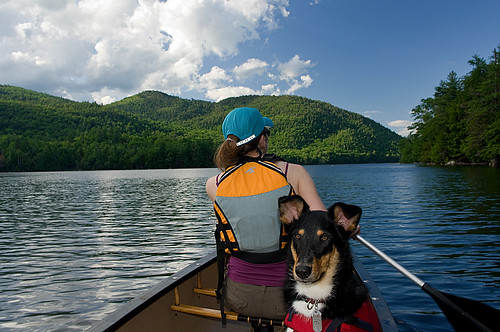
After 10 years of paddling in the Adirondack's we still haven't come close to paddling every reasonably accessible body of water, and that is a nice thing. This weekend we knocked another paddle off my list, Garnet Lake. A nice little lake I'd had on my list for a few years, Garnet is about 50% state owned shoreline and 50% private.
Although this is a nice short drive from home (about 1 hour, including 25 miles of winding secondary and dirt roads) it just isn't a big enough lake to really bother for a weekend trip. Aim and I easily knock out 15-20 miles a day in the Old Town Scout, which is pretty decent considering our high volume, gently rockered all purpose boat isn't the fastest on the water. Of course, we have been known to beat sleek sea kayaks on 14 mile flatwater paddles while paddling the Scout! Bearing that in mind, a 2 mile by 1/2 mile lake really isn't going to keep us busy for too long. However, every year we try to do our first paddle someplace cozy while we get our sea legs (and arms) back in shape.
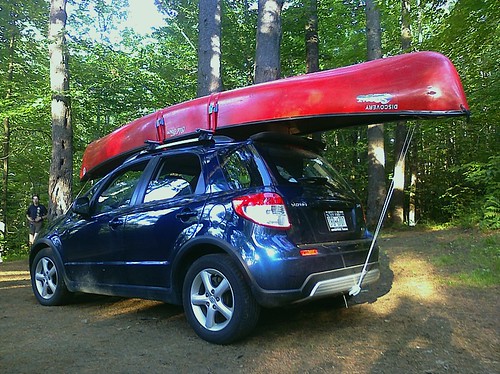
Aside from our first paddle of the year, this was also Colvin's first paddle of his entire life! It wasn't without some fear that we undertook this first paddle, but Colvin did great in the boat, and he is just a weekend away from being able to swim. The first day we paddled with him without his PFD (or rather CFD) because I'm pretty confident if we rolled he'd have figured out how to swim really quickly. On day two we decided to put it on him because I've had some people tell me that they were able to get their dog swimming faster by putting a PFD (that's a life jacket to all you land lubbers) on them for the first few swims. I think as soon as he learns to swim we are going to have a hard time keeping him out of the water!
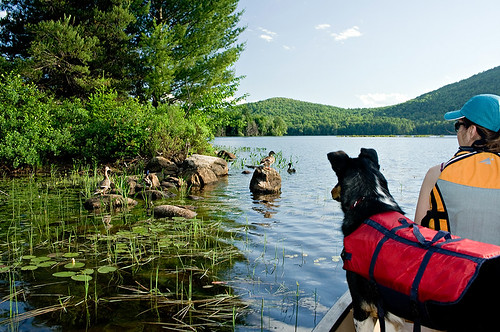
Other than peeing in the boat (our fault, he did try to tell us he had to go), Colvin actually did much better than Caney at listening to us, and of course he stayed in the boat and didn't swim the entire time we paddled. We didn't have a single group ask us if we were tormenting the poor dog by making him swim along side the boat like we did the first few years with Caney!
Garnet Lake, despite it's relatively small size, does have quite a bit of shoreline due to it's irregular shape and many coves. Almost 6 miles to be exact, and 2/3 of that is ringed by mountains making it quite scenic. The near 3000ft mountains thrust up 1500ft from the lakes 1400ft base elevation directly from the shoreline. The lake had quite a bit of wildlife, although we didn't see much. Some paddlers told us they spotted bald eagles on the southern terminus, we saw beaver lodges and other signs of beavers, and there were a pair of loons on the lake that we spotted several times. We also saw the less interesting ducks and geese.
Although the paddling is limited, the lake does have 2 short hikes that originate from it's shores. The first to Round Pond (one of many in the Adirondacks) and the second to Lizard Pond. The Lizard Pond hike is only accessible to those with a boat since the trail head is isolated and across the lake. Both hikes are less than 2.5 miles in each direction. I've definitely got Lizard Pond on my list as a paddle/backpack combo at some point in the future.
Saturday we set up camp at a pull-in site. We day paddled the state owned 2/3s of the shoreline and looked at the various campsites and trail heads. Most of the limited campsites were filled assuring us we made the right decision to car camp rather than canoe camp. After paddling and playing with Colvin in the water for most of the afternoon it started lightly raining when we got back to camp, I didn't feel like cooking, so we headed to North Creek for some pizza. Aim and I sat outside on the deck at Pete's Ah in North Creek while Colvin sulked in the car. The plan was to have him sit outside with us, but when I went to get him I noticed a DD's iced coffee cup thrown on my drivers seat. Unfortunately the cup had remnants of the ice water and some unfinished coffee/cream in it, actually a lot more coffee and cream than I'd have hoped for since it was a bad iced coffee. He got a bit of a earful and stayed in the car while we ate. When he hasn't been exercised I understand this behavior but when he spent all day playing and he was clearly tired (aka. happy in Border Collie terms), what he did was purely about spite because he was left in the car. This isn't the first time this has happened. I no longer have satellite radio as a result of 3 different chewing incidents in the car in which he systematically dismantled my well put together satellite system.
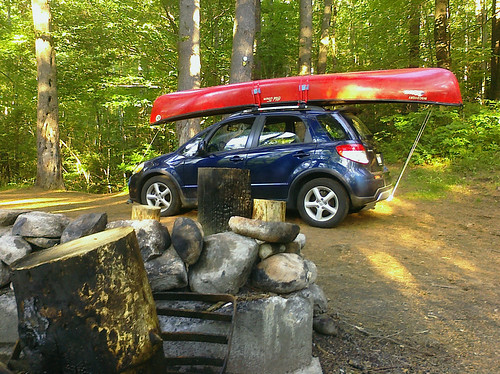
Saturday overnight it stormed so hard that we spent a good amount of time Sunday trying to remember when it stormed harder while we were camping. It definitely came in as a top 5 storm for rainfall severity and lightening, however, we've been in much worse when wind is factored in. I'm fine with the rain in the Marmot Swallow 2P, although the fly can get a little saggy if you don't restake it after it gets wet, the tent hasn't let me down yet on many a rainy weekend (or week)! For two people (and a dog) in summer conditions it's very livable and vents extremely well, even in the rain. But when I started seeing defined streaks of lightening hitting the shoreline of the lake outside my tent window, I got a little nervous!
Sunday, after spending most of the morning piddling around camp and drying out our gear, we packed up and eventually dragged the 70+lb Scout 500ft down to the water. Once on the water we paddled the private shoreline of Garnet Lake and then headed back towards the public half for a bit more exploring. In contrast to Saturday's hazy, hot and humid, Sunday was picture perfect. Lower humidity, better visibility and a mix of sun, blue skies and puffy white clouds. On a scale of 1-10 it was a 9.5 at least. Even the bugs were at a minimum.
All things considered, our fears were a bit over done, it was a perfect 1st weekend on the water, and a fun new place to explore. Colvin did great and I think we can head to some more difficult paddles from this point forward.
Posted by
Justin Serpico
at
Monday, June 21, 2010
0
comments
![]()
Technorati: Adirondacks, Colvin, Garnet Lake, North Creek, Old Town, paddling, Pete's Ah
Wednesday, June 9, 2010
Legislature Successfully Defends Paterson's Assualt On EPF
The following is not without some negative. The legislature did in some ways gut the EPF, but it didn't allow David A. Paterson to milk the EPF to cover his shortcomings as a leader. The legislature prevented him from using the EPF as a rainy day fund for the states day to day expenses, which was his initial goal.
The bottom line was that they cut about $78 million out of the EPF to fund the $11 million it (supposedly) cost to reopen the state parks and campgrounds that were closed.
I'm the first one to admit I'm not super smooth at math, but something isn't right. Basically Paterson held the NY State Parks as hostages while he demanded the funds from the EPF. So what he did was he said, the park system, which saw record visitation last year (and I'll assume near record revenue, or I'll again assume probably broke even in expenses) was too expensive to run, so if the legislature wanted to appease it's constituents it would have to deal the EPF.
See, unlike most of the Forest Preserve or the EPF, people and towns feel the crunch of the park closures instantly. It really hits home. Paterson tossed a grenade into the assembly and senate chambers and waited for someone to dive on it. Of course, there probably isn't one upstanding human being in the legislature, so they did the only thing they could, they tossed the EPF on it to save themselves.
Paterson is gutless, he's potentially a moron, but someone smart is pulling the puppet strings behind this guy. This was a move Joe "Prison Bound" Bruno would have been proud of.
Regardless, it's good to see New York State politics remain as corrupt as when Theodore Roosevelt literally had to break a leg off a chair to defend himself on the floor of the state capitol because he was one of just a few members of our government who would not tolerate the corrupt antics of our law makers.
ALBANY, N.Y. – The Adirondack Council today thanked the leaders of the NYS Senate and Assembly for standing up to a flurry of attacks on the NYS Environmental Protection Fund (EPF) proposed by Gov. David Paterson during this year’s budget negotiations.
Legislators today passed bills agreed to yesterday with Gov. Paterson that would reopen the state parks, historic sites and campgrounds closed by the Governor, while also preserving the funding and traditional spending priorities of the EPF.
While the overall spending levels for the EPF for FY 2010-11 are lower than the organization had hoped, the group praised the two Environmental Conservation committee Chairmen (Sen. Antoine Thompson of Buffalo and Assemblyman Robert Sweeney of Lindenhurst), as well as Senate Conference Leader John Sampson and Assembly Speaker Sheldon Silver, for making numerous improvements to the EPF in light of a $9 billion budget deficit.
“Today’s legislation would preserve the reliable funding source and the integrity of the Environmental Protection Fund, while reopening the state’s parks and campgrounds before the Memorial Day weekend,” said Brian L. Houseal, Executive Director of the Adirondack Council. “It would also allow the state to live up to some of its existing commitments to purchase and protect critical lands and waters that have been identified by the public for their recreational and ecological importance.”
The EPF’s 2010-11 total funding will be $134 million, down significantly from $222 million last year. The open space account for 2010-11 contains $17.6 million, much less than the $60 million from 2009-10, but it also rescinds Governor Paterson’s proposed moratorium on land protection. It is our understanding that the Governor has agreed to spend this money on land protection projects that the Legislature has allocated.
Not included in the EPF’s expenses are $11 million the Governor had proposed for paying state employees and day-to-day expenses at parks and historic sites. Also not included in the EPF’s expenses are $5 million for a portion of the state’s payment of taxes to local governments for state-owned land across the state. Both of those expenses are due to come from the state budget’s General Fund, as they have in past years.
“Legislative leaders recognize that all New Yorkers need clean air, clean water and safe places to play. We also need the tourism revenue that our parks, campgrounds and Forest Preserves and other open spaces provide to our citizens,” Houseal said. “We are grateful that they did so much to improve on the Governor’s plan.”
The EPF was created in 1993 and is funded primarily through a small Real Estate Transfer fee, to fund major environmental expenses. Eligible projects include municipal landfill closure, purchase and construction of recycling facilities and transfer stations; as well as the purchase of new lands and parks for environmental protection, recreation and historic preservation.
The EPF is a capital-projects-only fund, to ensure that its revenues would not be siphoned into paying day-to-day expenses, such as state employee salaries and benefits.
“If state agencies were allowed to pay their employees out of the EPF account, the EPF would be dry in just a few years,” Houseal explained. “We would never fund another capital project out of it. We’d be right back to borrowing for everything. Nobody wants that.”
“Governor Paterson followed the lead of his predecessors and tried to use the EPF to pay for staff and other administrative expenses,” Houseal said. “He wanted to change the very structure of the EPF. We are pleased the Legislature said ‘no.’”
The final agreement on the EPF passed both houses earlier today. The Assembly passed the bill by a vote of 86-47 just before 3 AM early Friday morning. The Senate passed the bill by a vote of 32-27 at 2:30 PM.
The Adirondack Council’s mission is to ensure the ecological integrity and wild character of the Adirondack Park. Founded in 1975, the Council is a privately funded not-for-profit organization with 18,000 members in all 50 United States. The Council carries out its mission through research, education, advocacy and legal action.
Additional comments on the "poisoned pill" compromise:
Land state should buy isn’t all in Ad’ks
To the editor:
In regard to your June 3 editorial ("This year, of all years, NY can't afford land"), it is critically important that Daily Enterprise readers understand that the Environmental Protection Fund preserves sensitive habitat, not just in the Adirondacks but around the state.
While the North County is blessed with abundant nature and open space, such is not the case in more crowded areas like the Hudson Valley and Long Island. For example, in the Long Island Pine Barrens - a sensitive ecosystem that protects clean drinking water for thousands of people - the threat of development is not simply an aesthetic one.
Conservationists have been in discussions with land owners in the Pine Barrens for years, in an effort to convince them not to sell out to another strip mall or subdivision. When Gov. Paterson threatened to suspend all habitat purchases earlier this year, the threat of defunding the open space line of the EPF nearly derailed negotiations and put the public's well being at risk.
Your criticism about very modest open space funding would be better directed at the cynical political process that gutted the Environmental Protection Fund in its entirety. By hiding a massive EPF cut in the bill that reopened state parks, Albany legislators slipped in a "poison pill" that truly shortchanged New York's treasured natural heritage.
We encourage Daily Enterprise readers who hunt, fish and otherwise enjoy the area's natural splendors to find out how their Albany representatives voted on environmental funding this year - and keep that information in mind when they go to vote next fall.Marcia Bystryn, president
New York League of Conservation Voters
via: Adirondack Daily Enterprise
Posted by
Justin Serpico
at
Wednesday, June 09, 2010
0
comments
![]()
Technorati: Adirondack Council, Adirondacks, Albany, David Paterson, environment, EPF, New York, politics, state parks, Theodore Roosevelt
Monday, June 7, 2010
Our Presidential Traverse Summed Up In a Photo!
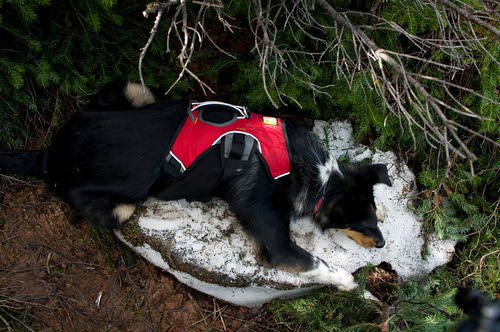
Although Colvin had been up to Thunderstorm Junction (~5,000ft) just below the summit of Mount Adams this winter, he had never been above treeline in the snow free season. The difference between the two seasons is stark and incomparable. Having had "Wonder Dog" for 10 years I forgot that not all dogs can effortlessly cruise over boulder fields like a mountain goat. Yet, Colvin is actually way ahead of Caney in almost every milestone for a trail dog. He's hiked more miles, spent more days car camping or at a hut, and ascended higher peaks than Caney by almost 9 months! By the end of this summer he'll have paddled at least 200 miles before Caney ever saw the inside of a boat, and he's already done well mountain biking. The only thing Colvin technically hasn't done yet is a backpacking trip, although you could consider his overnight trip to Grey Knob in New Hampshire a backpack.
So my initial disappointment with his fear of negotiating the boulder fields was tempered by the fact that he actually did really well. Caney set a high bar, and it's not reasonable to compare him to any other dog. Caney's FIRST trip to NH he effortlessly summited Mt Jefferson via the 3rd class Ridge of the Caps carrying a loaded backpack without any help whatsoever. Thinking about this in hindsight it is simply remarkable, and now I realize why I was often asked as I hiked above treeline in New Hampshire with Caney what I thought was a stupid question, "how does he do scrambling on the talus?"
To be honest, I never thought Colvin could complete the traverse. When we started planning it I didn't even have him yet, and once we got him I was immediately concerned about the time frame.
Athletically any young Border Collie can hike 20 miles of easy terrain in a day. They have the VO2 max almost 4X that of Lance Armstrong's super human statistic, and were bread for consecuctive 20+ mile days over rough hilly terrain. However, heat, abrasive talus and scree on the paw pads, as well as the mental demands of ascending and descending steep bouldery terrain in 30+ mph winds and 100% humidity, is altogether another factor. At 9 months Colvin is the equivalent of a 14.5 year old child in developmental terms. Putting it into perspective, forgetting the ancillary demands of a 20 mile alpine traverse, not many 14.5 year old humans could handle 16 hours and 18,000ft gain and lost on the trail.
Regardless, as the trip got closer, I gradually started facing reality. I knew his paws at best might hold up for a minimal (summitless) traverse if I protected them with booties. After a while I realized that was probably still unlikely, so I thought we would bail at Mt Washington with or without summiting Adams and Jefferson. Technically, all the elevation gain is over by Mt Washington, and the southern traverse is really just about mileage, but the hike out via the Tuckerman Ravine snowcat trail at the base of Mount Washington is easy enough that I could have carried him out without much difficulty back to Pinkham. Whereas the hike out via the Souther Presidential's is quite a bit more demanding in the descent back to Crawford Notch.
In the end, even that plan was a bit optimistic. However, there is a silver lining, despite dropping my hat and losing a couple of minutes (as in 2 minutes), and then prodding Colvin for almost 2 miles of above treeline hiking, we beat book time from Dolly Copp over the 5,367ft Mount Madison to the AMC Madison Spring Hut by over 20 minutes. Factoring in wind and humidity (creating slick talus and wet paw pads) that is pretty impressive considering Colvin literally started turning around to tell me we should go down at treeline, at times he wouldn't even continue without me going back for him. Basically, when he was moving he was moving pretty quickly.
As we descended Madison it was clear Colvin was mentally frazzled from the stress of rock hopping over and around the jumble of boulders that is the foot path above treeline. Worse, his paws were already showing signs of abuse, and he'd been wearing booties since the start of the descent, which is most rough on the front paws.
At Madison Hut we met back up with Mandy and Kevin who were ahead of us by at least 10 minutes, I raised the white flag. Although it was much less a surrender than the right decision. It was Colvin's hardest single day on the trail (although he actually gained about the same elevation during his winter trip to Grey Knob) and his first 5000ft summit. With the return trip it was just shy of a 10,000ft gain loss day, and just shy of 10 miles. Although he only gets credit for Madison, he essentially did a half traverse.
On the way down we were able to relax, take our time, and enjoy what turned out to be a spectacular day. We spent at least 2 hours just enjoying the day stopping for lunch below the summit and then enjoying the sunshine and clearing views from Osgood Junction for almost an hour!
After our hour long break at Osgood Junction I really wanted to take the Osgood Trail down to the Great Gulf trail, and then the Great Gulf Link trail literally back to our campsite at Dolly Copp. However, as we started on the Osgood I realized the extra 2 miles might be a real issue. Besides that the Osgood continued up and down on the ridge moreso than the Daniel Webster Scout trail which was mostly a straight down descent from the junction. In reality I'm almost certain the Osgood to Great Gulf Link would have been no harder because the Great Gulf Link trail is essentially a double track forest trail for 1.5 miles. Despite that, I couldn't escape the feeling that I was pushing him a little too hard with the extra mileage and we turned around about 5 minutes down the Osgood Trail.
Overall it was a good hike, and nothing to be ashamed of. Colvin was definitely pushed to his limits, he wouldn't even get out of the car Friday night. I had to carry him to the tent, and then feed and water him in the tent because he was too sore to walk on the rough ground.
We picked up Mandy and Kevin at Crawford Notch at 9:20pm. They made excellent time and had absolutely outstanding weather from Mount Adams onward, plus they got a little taste of just how bad an average day above treeline can be in the Northern Presidential's.
Saturday we took a short walk along the river, but Colvin mostly rested in the tent while I tried to dry out our gear from a typical rainy NH/Great Gulf stay. Following the 4.5 hour drive home Saturday night he had enough energy to get his toys out of the bin, and even chase them a few times. Sunday he was ready to play indoors but still tender outside, but I thought a short lowland trail to a lake would be OK. Colvin ended up hiking/bushwhacking about 4 miles and almost did his first swim after playing in the water for about 20 minutes.
Posted by
Justin Serpico
at
Monday, June 07, 2010
1 comments
![]()










